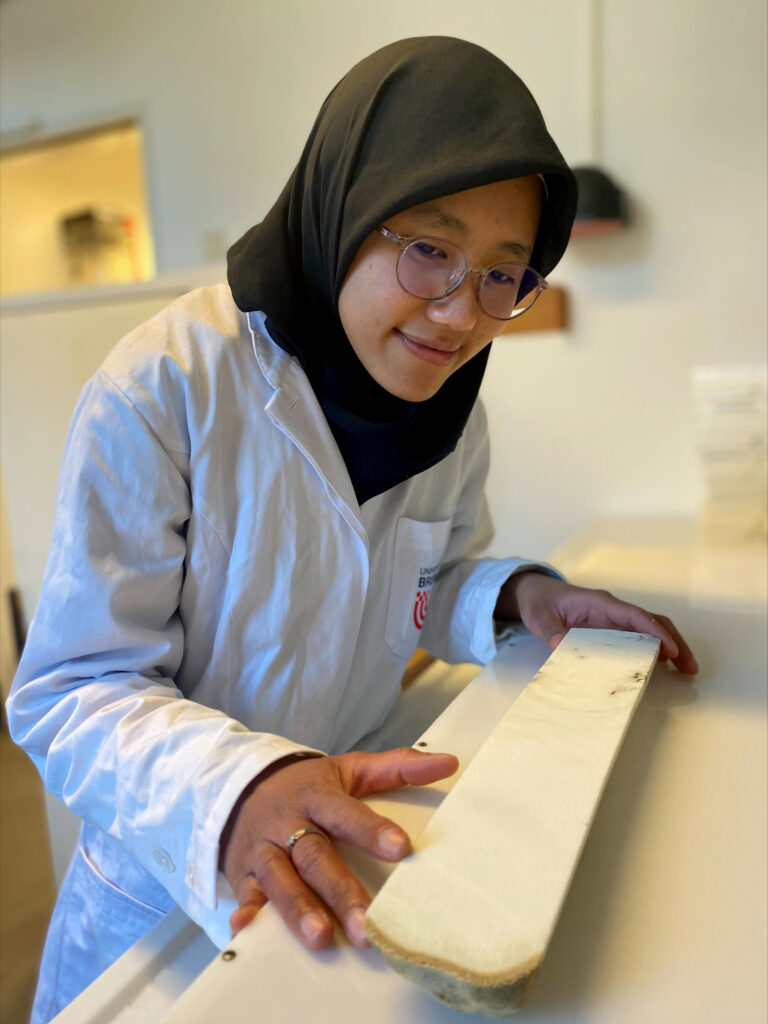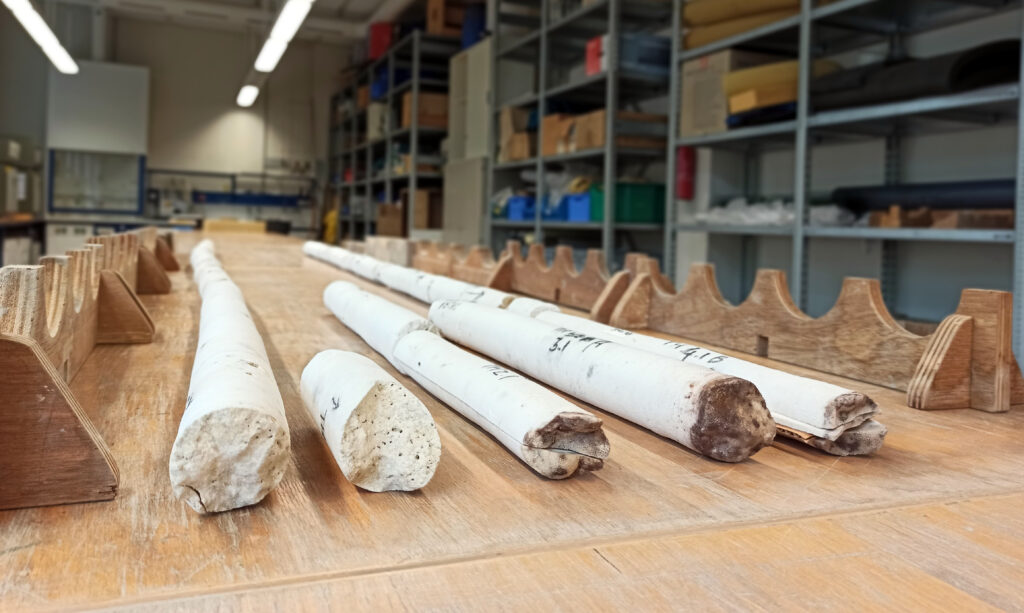Written by; Hana Camelia and Hayat Nasirova – Edited by; Jessica Hargreaves
Coral reefs are one of the most vital and diverse marine ecosystems globally, with around a quarter of marine life and human populations dependent on them (Buddemeier et al., 2004). Unfortunately, according to the Intergovernmental Panel on Climate Change – IPCC, their presence is being threatened by increasing global sea surface temperature (IPCC, 2019). Prolonged exposure to high sea surface temperature can cause the breakdown of the symbiotic relationship between corals and their algal symbionts, called zooxanthellae. The breakdown of this relationship often results in algae leaving the corals’ tissue, and the loss of a corals major source of food causing the beautiful coral colours to turn white. This is generally referred to as coral bleaching. If these thermal stress conditions continue and corals continue to bleach, this could lead to the death of large areas of coral reef.
Understanding past thermal stress events, and how corals respond to these events is an area of research that will be addressed by the DFG funded Priority Programme on ”Tropical Climate Variability & Coral Reefs” (SPP 2299). This programme aims to better understand tropical marine climate variability and the impact of warming extremes on coral reef ecosystems globally. One project within the programme, the ‘’Climate and environmental change in the Andaman Sea since the late Little Ice Age: Sea surface temperature, hydroclimate, and coral response to thermal stress in the northeastern Indian Ocean (IndOC-E)’’ project based at MARUM – Center for Marine Environmental Sciences/University of Bremen, led by Dr. Thomas Felis, focuses on these processes across the northeastern Indian Ocean back to the late Little Ice Age (late 1700s) period.
A useful method to investigate these processes is through the generation of climate reconstructions from tropical shallow-water corals. Massive, boulder-like coral colonies, such as the Porites spp. corals used in the IndOC-E project, deposit a hard skeleton of calcium carbonate (CaCO3), which supports the softer tissue living portion of the coral. As these corals grow, their skeleton forms layers similar to tree rings, and incorporates environmental information about the region the coral is growing in. Corals preserve climatic information for their entire life, which can span up to several centuries.


To reveal this historical climate corals are cored through the skeleton, and subsequently slabbed. X-rays are then taken of coral slabs, a similar process to taking an X-ray of your arm, which can reveal patterns of alternating light and dark layers that are the result of seasonal changes in growth. A pair of light and dark layers represent 1 year of growth and can be used to determine the age of the coral by counting layers from the year it was sampled (the top of core) to the bottom of core.
By using these methods, Hana Camelia, a PhD candidate in the IndOC-E project, is working with Porites spp. corals taken from Ko Racha Yai (Thailand) in the southern Andaman Sea. Hana will sample at high-resolution, at least monthly resolution, and geochemical analyses will be performed to reconstruct past sea surface temperatures, hydrological changes, and coral stress responses. Corals in this location can grow at approximately 1-2 cm/year, meaning that for the longest coral in the Andaman Sea collection, which is 286 cm, the record could span up to 286 years long. The corals will highlight changes in climate up until the late 1700s or early 1800s across the southern Andaman Sea (Thailand)!
What do these records help us with?

Coral reconstructions are particularly helpful in locations like the Andaman Sea which is relatively understudied and do not have very good observational records. The IndOC-E team will have the unique opportunity to investigate a number of important climatic and extreme conditions in the Andaman Sea and explore their relationships across the Indian Ocean basin.
One of the interesting aspects of this project is that the unique settings of IndoC-E’s study site (Ko Racha Yai) allows a direct comparison between reefs with a natural refuge from thermal stress conditions and reefs which are exposed to extreme thermal stress conditions. The western side of Ko Racha Yai is influenced by mitigating cooling effects of large amplitude internal waves, which likely support the resilience of these western reefs, while the eastern side does not experience the same relief (Wall et al., 2015).
Internal waves have been found to explain localised differences in coral bleaching and large mortality events. During May 2010, the timing of a global mass bleaching event, regions of the Andaman Sea did not experience the same level of bleaching as was expected from the large sea surface temperature increases (Schmidt et al., 2016; Wall et al., 2015). It turned out that despite the surface water heatwave, frequent intrusions of colder deep water were reaching the shallower waters, due to internal waves. Internal waves cool the surrounding reefs, and provide a refuge for coral reefs during the bleaching event. Conversely, reefs around the Andaman Sea which are not exposed to these internal waves suffered more severe bleaching during the same period.
One of the main outcomes of this project will be to assess how the amplitude of internal waves modulates variability on a localised scale, by comparing coral records from either side of the island. Hopefully the IndOC-E project will be able to reconstruct a direct comparison of coral responses to thermal stress events since the late 1700s.
Why should we care?
The IPCC indicates with ‘high confidence’ that tropical coral reef ecosystems will suffer significant loss, even if we are able to limit global warming to 1.5°C (IPCC, 2019). Marine heatwaves, which characteristically result in prolonged elevated sea surface temperature, are likely to become more frequent, intense and longer in duration under a warming climate (Holbrook et al., 2020). Reducing the time intervals between these events and the associated bleaching, may not allow enough recovery time for many reef ecosystems (Hughes et al., 2018).
Understanding natural reef refugia sites, like this project’s study site in the Andaman Sea, is vital as they will be instrumental locations for coral survival through future warming conditions. The IndOC-E project of the DFG Priority Programme on ”Tropical Climate Variability & Coral Reefs” (SPP 2299) will be the first reconstruction beyond the 20th century in the Andaman Sea region and provides a rare opportunity to explore climate variability and thermal stress in the eastern Indian Ocean basin.
References
- Buddemeier, R.W., Kleypas, J.A. and Aronson, R.B., 2004. Coral reefs Potential Contributions of Climate Change to Stresses on Coral Reef Ecosystems and Global climate. Pew Center on Global Climate Change, Arlington, VA, p.55.
- IPCC, 2019: Summary for Policymakers. In: IPCC Special Report on the Ocean and Cryosphere in a Changing Climate [H.-O. Pörtner, D.C. Roberts, V. Masson-Delmotte, P. Zhai, M. Tignor, E. Poloczanska, K. Mintenbeck, A. Alegría, M. Nicolai, A. Okem, J. Petzold, B. Rama, N.M. Weyer (eds.)]. In press.
- Wall, M., Putchim, L., Schmidt, G.M., Jantzen, C., Khokiattiwong, S. and Richter, C., 2015. Large-amplitude internal waves benefit corals during thermal stress. Proceedings of the Royal Society B: Biological Sciences, 282(1799), p.20140650.
- Schmidt, G.M., Wall, M., Taylor, M., Jantzen, C. and Richter, C., 2016. Large-amplitude internal waves sustain coral health during thermal stress. Coral Reefs, 35, pp.869-881.
- Holbrook, N.J., Sen Gupta, A., Oliver, E.C., Hobday, A.J., Benthuysen, J.A., Scannell, H.A., Smale, D.A. and Wernberg, T., 2020. Keeping pace with marine heatwaves. Nature Reviews Earth & Environment, 1(9), pp.482-493.
- Hughes, T.P., Anderson, K.D., Connolly, S.R., Heron, S.F., Kerry, J.T., Lough, J.M., Baird, A.H., Baum, J.K., Berumen, M.L., Bridge, T.C. and Claar, D.C., 2018. Spatial and temporal patterns of mass bleaching of corals in the Anthropocene. Science, 359(6371), pp.80-83.

Pingback: SPP 2299 Early Career Researcher Meeting March 2023
Pingback: SPP 2299 Heading to the Asia-Pacific Coral Reef Symposium